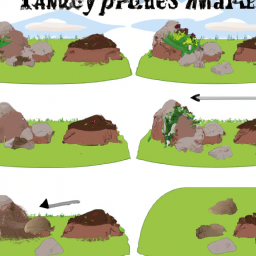Removing Landscaping Rocks How To
Table of Contents []
How To Remove Landscaping Rocks
1. What are Landscaping Rocks?
Landscaping rocks are a variety of stones and pebbles used to decorate and improve the aesthetics of residential and commercial properties. These rocks provide a vast array of texture and color that can benefit the landscape's appearance. Not only can landscaping rocks improve the aesthetics of a property, but they can also help conserve water and provide an excellent way of controlling weeds.
2. Types of Landscaping Rocks
The types of landscaping rocks available are varying and can even be mined from local rock quarries. Common types of rocks used for landscaping include:
- Granite
- Limestone
- Sandstone
- River Rocks
- Marble Chips
- Crushed Gravel
3. Benefits of Landscaping Rocks
The benefits of using landscaping rocks as a decoration are numerous. They can help protect soil loss, aid with moisture control, offer a timeless look, and increase property value.
Using landscaping rocks to protect soil loss is a common practice all over the world. Rocks can be used to protect/stabilize the soil and can serve as a good solution for keeping dust in check. Rocks can also aid with moisture control in gardens and can significantly reduce the need for watering.
Finally, landscaping rocks offer a timeless look that will never go out of style. They can come in a variety of sizes and colors to match any style house. Besides the look, landscaping rocks can also increase property value.
4. How to Remove Landscaping Rocks
Removing landscaping rocks is often required when undertaking various projects, such as building a patio or a pool. Depending on the size of the rocks, it could be relatively easy or a bit more time consuming.
The basic steps to removing landscaping rocks are:
- Assess the size of the rocks
- Add necessary supplies
- Pick up the rocks one by one
- Put the rocks aside in a prepared area
- Repeat until all the rocks are removed
When dealing with large rocks, it's best to lower the level of the turf around the rock before removing it. It's also a good idea to be prepared with some muscles and comfortably padded gloves.
5. What to do with the Removed Material?
Once the rocks have been removed, it is important to know what to do with them. The rocks can be used in other areas of the landscape, donated, or sold. Alternatively, they can also be recycled at various local stone dealers, depending on the type of rock used.
6. Safety and Cleanup Considerations
It is essential to consider safety when removing landscaping rocks. Ensure there is a flat space to work from where the rock can be safely placed, while also taking proper steps to avoid injury when lifting and moving them.
As with any project, it is also important to clean up after removing the rocks. Any leftover debris from the project should be disposed of properly.
7. Potential Challenges
There are a few potential challenges to consider when removing landscaping rocks. Depending on the specific type of rock being removed, the size of the stones, and the area where they are located, the project could be difficult.
Removing boulders or large rocks requires the use of specialized equipment and thorough planning. It is also necessary to consider the safety of the crew, workers, and landscape when removing large and heavy stones.
8. Cost Considerations
The cost of removing landscaping rocks can vary widely depending on materials used and labor. Small rocks are usually simple to remove and can be done at a minimal cost. If the rocks need to be replaced, the costs become more significant.
Similarly, if large rocks or boulders need to be removed, specialized equipment may be needed, increasing the financial cost. In these cases, it is important to factor in all costs associated with the project before getting started.
Final Word
In conclusion, removing landscaping rocks is a simple process in some cases, while more complex projects require specific knowledge and special equipment. In any case, it is essential to consider safety, preparation, and cost before beginning the project.
Whether undertaking the project yourself or hiring a professional, understanding the nuances associated with removing landscaping rocks is key to having a successful outcome.

Previous Page
Next Page
